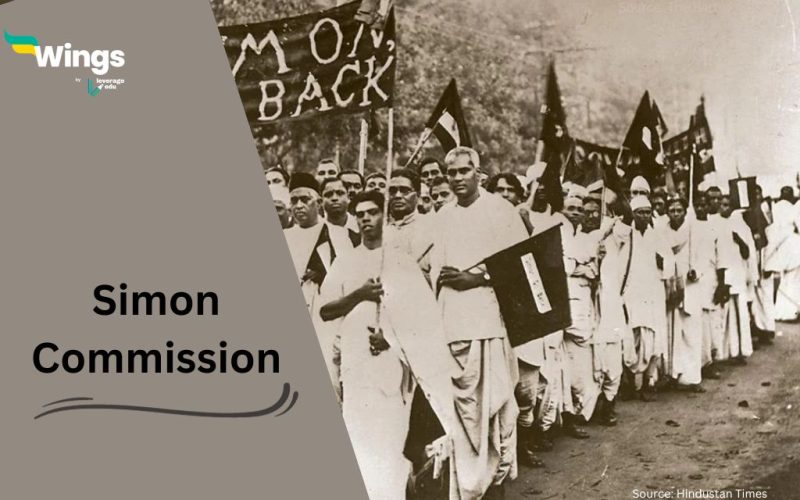The struggle for India’s independence from British colonial rule is a saga of relentless determination, sacrifice, and unwavering commitment to sovereignty. Amidst this arduous journey, one pivotal event that stands out is the arrival of the Simon Commission, officially known as the Indian Statutory Commission, in 1928. This commission, comprising seven members of the British Parliament under the chairmanship of Sir John Simon, was tasked with studying constitutional reform in the British Empire’s largest and most significant colony.
In this blog post, we will delve into the profound impact of the Simon Commission on India’s fight for independence, examining its background, the protests it ignited, its recommendations, and the enduring legacy it left behind.
Must Read: What was Khilafat Movement?
Background: Seeds of Discontent
Table of Contents [show]
The origins of the Simon Commission can be traced back to the Montagu–Chelmsford Reforms of 1919 when the British government pledged to send a commission to India after a decade to assess the effects and operations of the constitutional reforms and suggest further changes. However, in November 1927, the British government decided to expedite the commission’s arrival by two years, a move that triggered strong opposition from prominent Indian leaders such as Mahatma Gandhi, Jawaharlal Nehru, and Muhammad Ali Jinnah. The primary bone of contention was the absence of any Indian representation on the commission, an issue that fueled resentment and protests.
Protests and Tragedy: Lala Lajpat Rai’s Sacrifice
The arrival of the Simon Commission in India in early 1928 set off a wave of protests across the country. Everywhere the British MPs went, they were met with demonstrators carrying black flags bearing the slogan “Simon Go Back.” In Lahore, the commission encountered a particularly infamous protest led by the revered Indian nationalist Lala Lajpat Rai. During this protest, police brutality led to Lala Lajpat Rai sustaining critical head injuries, eventually resulting in his tragic death on November 17, 1928. His sacrifice galvanized the Indian nationalist movement and intensified the call for self-governance.
The Simon Commission’s Recommendations
Despite the controversy surrounding its composition, the Simon Commission published a two-volume report in May 1930. The recommendations were groundbreaking and included abolishing the diarchy system, extending autonomy to provinces, and retaining separate electorates in response to inter-communal tensions. However, the report conspicuously omitted any mention of dominion status, leaving a significant gap in the aspirations of Indian nationalists.
Response and Counter Proposals
In response to the Simon Commission’s report, Motilal Nehru presented the Nehru Report, advocating for dominion status with complete internal self-government for India. Jinnah countered with his Fourteen Points, outlining the Muslim community’s demands within the framework of British rule. Additionally, Viceroy Lord Irwin’s declaration in 1929 hinted at a vague promise of dominion status in the distant future, further reshaping the political landscape.
The Aftermath: Government of India Act 1935
The Simon Commission’s enduring impact materialized in the form of the Government of India Act 1935. This legislation established responsible provincial governments in India, marking a significant step toward self-governance. While it fell short of granting full sovereignty to India, it laid the foundation for the subsequent development of the Indian Constitution.
Significance
The Simon Commission, formed by the British government in 1927 to review and recommend constitutional reforms in India, is chiefly remembered for its exclusion of Indian members, which triggered widespread protests and marked a critical juncture in the Indian struggle for independence. The absence of Indian representation among the commission’s members symbolized British colonial arrogance and galvanized the Indian populace to demand self-rule. This pivotal moment led to nationwide demonstrations, notably the protest in Lahore in 1928 where Lala Lajpat Rai was fatally injured, and ultimately paved the way for more inclusive discussions between British officials and Indian leaders, setting the stage for constitutional reforms in India and, eventually, its independence in 1947. The Simon Commission, in its arrogance, unwittingly served as a catalyst for the larger independence movement and demonstrated the Indian people’s unwavering commitment to determining their own destiny.
Quiz Time
Results
#1. Who chaired the Simon Commission?
#2. What was the primary reason for the Indian National Congress and other Indian leaders boycotting the Simon Commission?
#3. What significant event occurred during a protest against the Simon Commission in Lahore in 1928?
Stay informed about Indian history and broaden your general knowledge with our dedicated section. If you have inquiries about studying abroad, don’t hesitate to reach out to Leverage Edu.
 One app for all your study abroad needs
One app for all your study abroad needs


















 45,000+ students trusted us with their dreams. Take the first step today!
45,000+ students trusted us with their dreams. Take the first step today!
